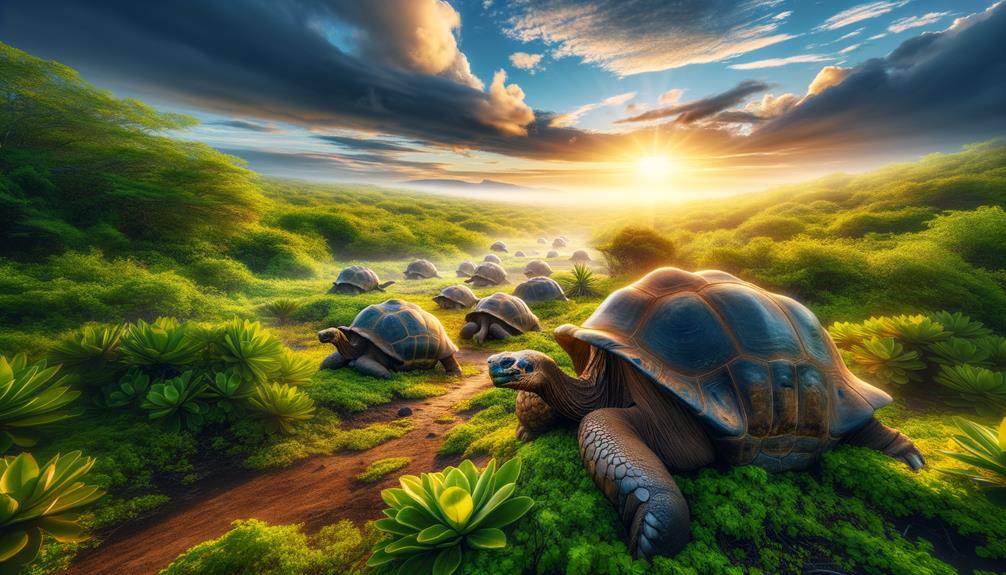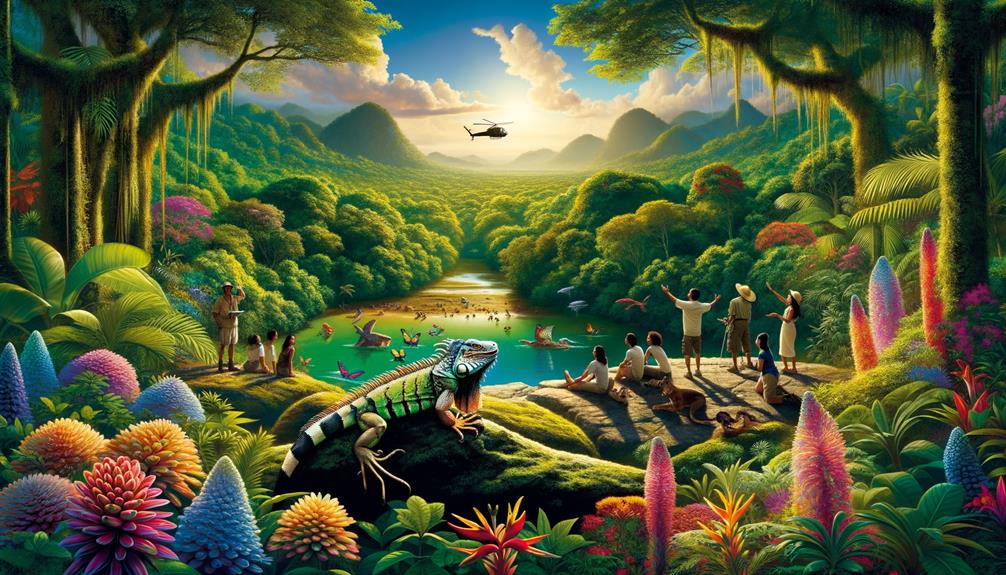With fewer than 1,000 Siamese crocodiles remaining, their survival is precarious due to habitat destruction, poaching, and accidental catching. Conservation efforts focus on safeguarding Cambodia's Cardamom Mountains and establishing community-managed sanctuaries. Anti-poaching initiatives involve regular patrols and awareness campaigns to deter would-be poachers. Breeding programs have produced over 1,000 crocodiles for reintroduction, but maintaining genetic diversity poses a significant challenge. To boost nest survival rates, conservationists employ predator-proof enclosures and artificial incubation. Community involvement is vital to the success of these conservation efforts. As you read on, you'll learn how these remarkable creatures are slowly making a comeback.
Key Takeaways
In Cambodia's Cardamom Mountains, local community wardens manage in-situ sanctuaries, providing a safe haven for the Siamese crocodile population.
Captive breeding programs have been successful in producing over 1,000 Siamese crocodiles, which are then reintroduced to protected habitats.
To combat poaching, local wardens, camera traps, and law enforcement agencies work together to prevent illegal activities.
Indigenous groups partner with conservation efforts, monitoring the population and helping to prevent illegal activities.
To increase nesting success and hatchling survival, predator-proof nest enclosures and artificial incubation are being implemented.
Current Population Status
The current population status of the Siamese crocodile is alarming, with fewer than 1,000 individuals remaining globally, mainly found in Cambodia's Cardamom Mountains. As a critically endangered species, the wild population of Siamese crocodiles is on the brink of extinction, having declined by over 80% in the past three generations. Habitat loss, poaching, and incidental bycatch are the primary causes of this drastic drop.
Siamese crocodiles are now largely confined to remote and degraded wetland habitats. The few remaining reproductive colonies are scattered across Cambodia, Laos, and Vietnam. The marginal habitat within the Cardamom Mountains, while offering some refuge, is suboptimal and associated with slower growth and reproduction rates compared to the lowland regions, further exacerbating the species' precarious status.
Accurate population estimates are difficult to obtain due to the elusive nature of these crocodiles. However, experts agree that the global count likely stands at just a few hundred individuals. This stark reality highlights the urgent need for immediate and sustained conservation efforts to protect the Siamese crocodiles and facilitate their wild population's recovery.
Habitat Protection

Securing the Cardamom Mountains' habitats is vital for the survival of Siamese crocodiles, as it is home to the largest remaining wild population. Protecting this region requires a multi-faceted approach. Establishing in-situ sanctuaries, managed by local community wardens, is a critical step. These sanctuaries safeguard key habitats, ensuring crocodiles have safe breeding grounds and access to ample food sources.
Local communities play a vital role in habitat restoration and management efforts. By working together, we can strike a balance between human activities and wildlife conservation. Community members, with their intimate knowledge of the land, can act as environmental stewards, ensuring the long-term protection and monitoring of these areas.
Conservation efforts must also focus on the larger landscape. Maintaining connectivity between fragmented populations in the Greater Mekong region helps preserve genetic diversity and resilience. This requires coordinated efforts across different regions and stakeholders.
Stronger land-use regulations and enforcement are also necessary. Preventing the conversion of wetlands and riverine habitats into agricultural lands will help preserve the natural environment that Siamese crocodiles depend on. Through these combined efforts, we can ensure the survival and recovery of this endangered species.
Anti-Poaching Efforts
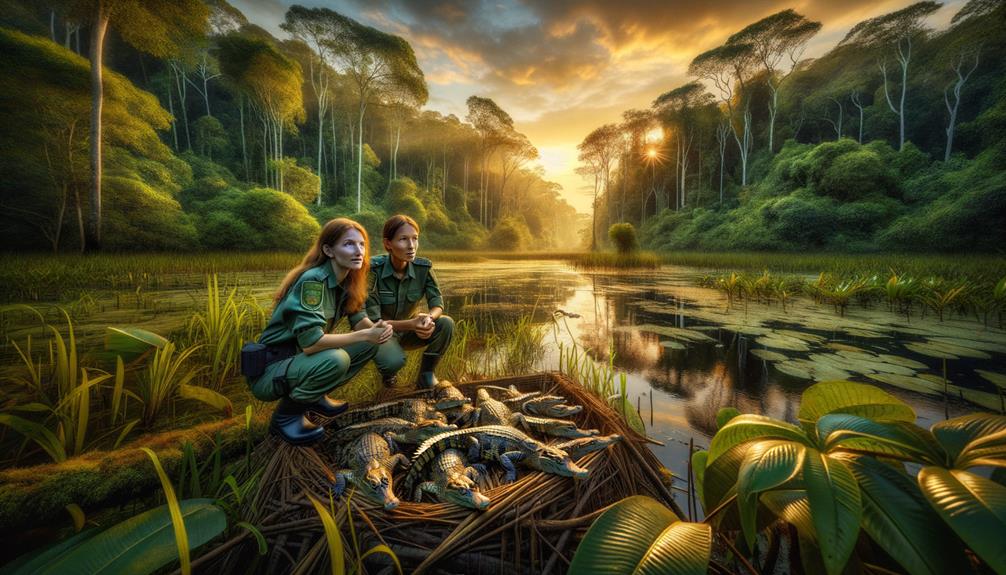
In the heart of the Cardamom Mountains, our mission to protect the Siamese crocodile population relies heavily on anti-poaching efforts. By combining conservation initiatives with regular patrols, we've created a safer environment for these incredible creatures. Local community wardens play a vital role, monitoring sanctuaries and using camera traps to detect and deter poaching activities. Their vigilance has significantly reduced illegal hunting and habitat destruction.
Our partnership with law enforcement agencies has strengthened our anti-poaching initiatives. Several individuals involved in the illegal Siamese crocodile trade have been arrested and prosecuted, sending a clear message that poaching will not be tolerated. This legal backing reinforces our on-the-ground efforts, making our conservation strategy more robust and effective.
Empowering local communities has also been crucial. Our community-based conservation initiatives have instilled a sense of ownership among residents, who now actively participate in protecting the Siamese crocodiles. Public awareness campaigns highlighting the Critically Endangered status of these reptiles have garnered widespread support, further discouraging poaching activities. These collective efforts form a comprehensive approach that ensures the continued recovery of the Siamese crocodile population.
Breeding Programs
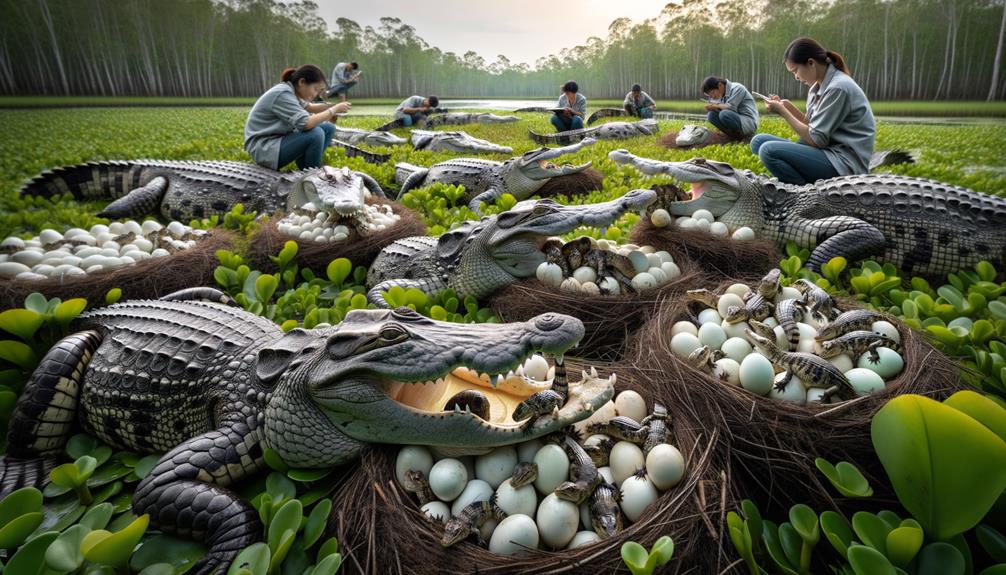
Here's how captive breeding programs have made a real difference in Southeast Asia. In Cambodia, Laos, and Thailand, these initiatives have successfully produced over 1,000 Siamese crocodiles for reintroduction into the wild. Genetic testing has been crucial in ensuring the genetic purity of these populations, which is vital for preventing hybridization. However, releasing these young crocodiles into protected wetlands is only the first step. We also need to address the challenges that come with securing habitats and mitigating human-crocodile conflicts if we want to guarantee their long-term survival.
Captive Breeding Successes
Since 2012, our captive breeding programs have made significant strides, successfully hatching and rearing over 100 Siamese crocodiles. This progress is crucial for their reintroduction into the wild, ensuring that captive Siamese crocodiles not only survive but thrive. By focusing on breeding pure Siamese crocodiles, we've reduced the risk of hybridization, maintaining the species' genetic integrity.
We've taken a meticulous approach, establishing genetic testing laboratories to identify and secure pure Siamese crocodiles. This ensures that only genetically pure individuals contribute to our breeding efforts, preserving the species' authenticity. This step is vital, as it forms the foundation of our entire recovery strategy.
Our collaboration with local communities has been vital. Public awareness campaigns have garnered significant support, fostering a sense of shared responsibility. Local community wardens manage protected sanctuaries in the Cardamom Mountains, where the largest known wild population resides. This synergy between scientific rigor and community involvement has been key.
We've also employed advanced telemetry methods, such as satellite and PIT tags, to monitor released crocodiles. This allows us to track their movements and survival rates, providing valuable data to refine our strategies. While our journey is ongoing, the progress we've made is undeniable.
Genetic Diversity Challenges
Maintaining genetic diversity in our captive breeding programs is a significant challenge due to the limited number of founding individuals and the inherent risk of inbreeding. This genetic bottleneck can severely impact the gene pool, leading to reduced fitness and adaptability among Siamese crocodiles in captivity. To address this, we rely on genetic testing to identify pure-bred individuals and prevent hybridization with other crocodilian species.
Through strategic pairing of breeding individuals, we minimize the loss of genetic diversity. This approach ensures a robust gene pool, which is vital for the long-term viability of the species. It's not just about increasing numbers; it's about ensuring those numbers have the genetic resilience to thrive.
Release Into Wild
Having established a strong genetic foundation within our captive breeding programs, we're now shifting our focus to the crucial task of releasing these resilient Siamese crocodiles back into their natural habitats. Between 2012 and 2020, our conservation project successfully reintroduced over 100 crocodiles into the wild, marking a significant step toward rebuilding wild populations.
The release process begins with selecting genetically viable individuals. Our genetics laboratories conduct rigorous tests to ensure each crocodile is a purebred Siamese, preserving the species' integrity. Once selected, these crocodiles are transported to protected in-situ sanctuaries in the Cardamom Mountains, where local community wardens provide a safe haven for their survival and adaptation.
Local communities play a vital role in this conservation project. By working together, we've received invaluable support and participation in monitoring and protecting the reintroduced populations. Public awareness campaigns have further strengthened these efforts, educating residents about the importance of Siamese crocodile conservation and the broader ecological benefits.
Releasing these majestic reptiles back into the wild not only revitalizes their populations but also represents a profound step toward ecological balance and freedom for these critically endangered creatures.
Nesting Success Strategies
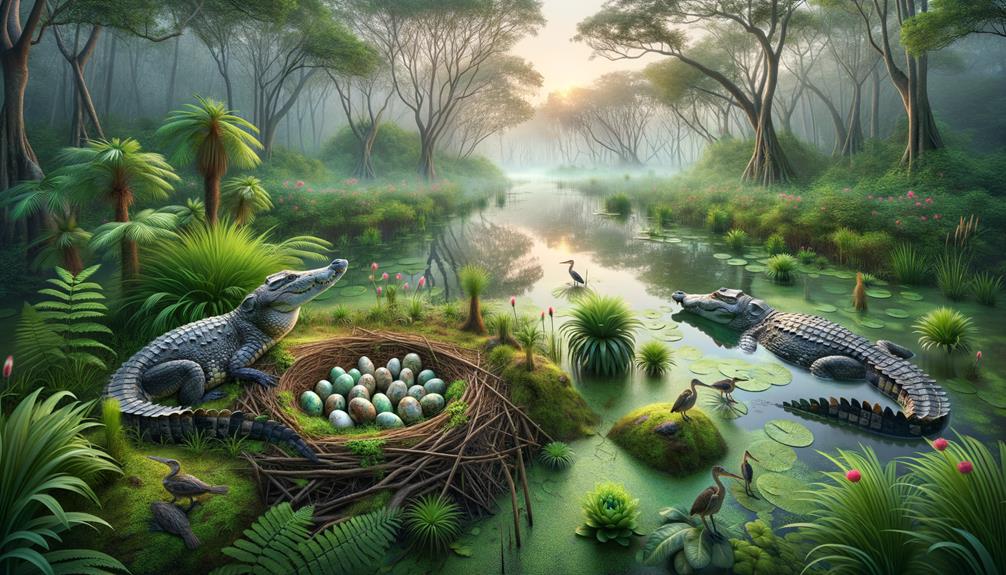
When it comes to boosting Siamese crocodile nesting success, I prioritize three key strategies: identifying optimal nest sites, fending off predators, and regulating the incubation environment. The right location can significantly impact hatchling survival rates, while effective predator deterrence ensures more eggs reach hatching. By refining these approaches, we can create conditions that favor higher rates of successful nests and healthier juvenile recruitment.
Nest Site Selection
Selecting the right nesting site is vital for Siamese crocodiles, as it directly affects the survival rates of both eggs and hatchlings. During the dry season, typically from March to April, these reptiles build mound nests on floating vegetation, riverbanks, or under tree canopies. Each nest holds around 11 to 26 crocodile eggs, and the chosen location significantly impacts their chances of survival.
Temperature plays a crucial role during the 70-80 day incubation period, influencing the sex of the hatchlings. As a result, the ideal thermal conditions at the nest site are critical for balanced sex ratios and overall nest success. The perfect sites also offer shelter from extreme weather and flooding, increasing the eggs' chances of hatching successfully.
The timing of hatchling emergence during the wet season, from May to June, coincides with periods of abundant food and cover, further aiding their survival. However, low nest success and hatchling survival rates remain significant obstacles for the species' recovery. Identifying and protecting these optimal nesting sites is critical to ensuring a higher rate of successful hatches, ultimately helping to boost the population of these endangered reptiles.
Predator Deterrence Methods
Employing effective predator deterrence methods has significantly boosted nesting success rates for Siamese crocodiles, offering a promising strategy for their population recovery. The installation of predator-proof nest enclosures has been particularly successful, increasing nesting success rates by up to 80% in protected areas. These enclosures safeguard the nests from potential threats, allowing the eggs to develop undisturbed.
Acoustic deterrents provide an additional layer of protection by emitting sounds that repel tigers, leopards, and other large carnivores known to prey on crocodile nests. This innovative approach creates a safer environment for the eggs, substantially reducing the risk of predation.
Crocodile monitor teams play a vital role in this multi-faceted approach. Trained teams regularly patrol nesting areas, providing on-the-ground surveillance and promptly responding to any disturbances. Their vigilance ensures that any threats are swiftly addressed, leading to higher hatchling survival rates.
Incubation Environment Control
To ensure the successful development of Siamese crocodile eggs, we meticulously control the incubation environment by maintaining precise temperature and humidity levels. This attention to detail is crucial because the ideal temperature range of 30-32°C and humidity levels between 90-95% can result in hatchling success rates as high as 90%.
Temperature Control: Our incubators are set to the ideal temperature range, as even slight fluctuations can affect the sex ratio of the hatchlings.
Humidity Monitoring: We constantly monitor humidity levels using hygrometers to prevent the eggs from drying out or becoming too moist, both of which can be detrimental.
Nest Construction: For natural nests, we ensure proper construction with the right mound height, vegetation cover, and proximity to water. These factors greatly enhance natural nesting success, which is typically below 50%.
Artificial Incubation and Head-starting: By incubating eggs artificially and rearing hatchlings in captivity for 12-24 months, we've significantly boosted survival rates from less than 10% in the wild to over 60%.
These methods are part of a thorough effort to bolster the Siamese crocodile population and guarantee their continued recovery in the wild.
Community Involvement
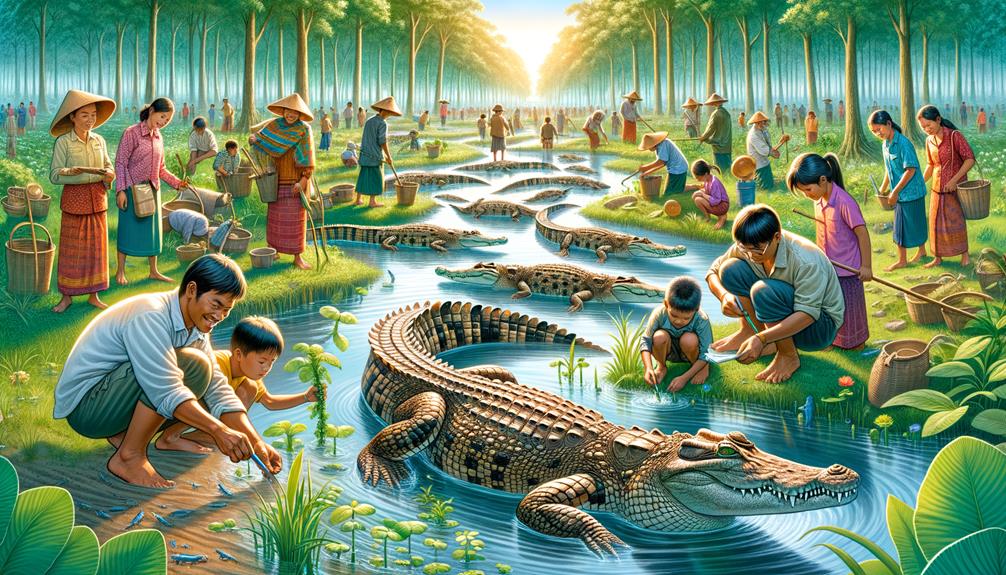
Engaging local communities in Cambodia as wardens for managing and protecting in situ sanctuaries has been crucial in the recovery of Siamese crocodile populations. Across Southeast Asia, conservation efforts have partnered with indigenous groups to monitor populations and prevent illegal hunting and habitat encroachment. This grassroots involvement has created a powerful alliance for the conservation of these crocodiles.
Public awareness campaigns have been vital in gaining local support. By discouraging the consumption of crocodile meat and trade in skin products, these campaigns have shifted community perspectives towards valuing crocodile preservation. Community-based ecotourism initiatives have also provided alternative livelihoods, offering local stakeholders economic incentives to protect rather than exploit these animals.
Participatory land-use planning has further strengthened this collaborative approach. By involving local stakeholders, we've identified suitable habitats for crocodile reintroduction and expanded protected areas effectively.
Community involvement has been instrumental in our conservation strategy:
| Initiative | Purpose | Impact |
|---|---|---|
| Community Wardens | Manage/protect sanctuaries | Reduced illegal hunting and encroachment |
| Public Awareness Campaigns | Discourage crocodile meat/skin trade | Increased local support for conservation |
| Community-based Ecotourism | Provide alternative livelihoods | Economic incentives for crocodile protection |
| Participatory Land-use Planning | Identify habitats/expand protected areas | Effective reintroduction and habitat preservation |
Frequently Asked Questions
How Many Siamese Crocodiles Are Left in the World?
The global wild population of Siamese crocodiles has dwindled to fewer than 1,000 individuals. Cambodia is home to the largest population, with estimates ranging from 200 to 400. Despite some stabilization, these critically endangered creatures still face significant threats to their survival.
Why Are Siamese Crocodiles Endangered?
Siamese crocodiles are critically endangered due to a combination of threats. Overhunting and habitat loss are the main culprits, while poaching, fishing gear entanglement, and genetic issues stemming from small populations also contribute to their precarious situation.
What Are the Threats to the Siamese Crocodile?
The Siamese crocodile faces numerous threats. Poaching, habitat loss due to rice farming, and accidental capture in fishing gear all contribute to the decline of this species. Additionally, small and fragmented populations are vulnerable to genetic issues and unpredictable events, which further jeopardize their survival.
Are Siamese Crocodiles Aggressive?
Imagine facing a fearsome creature, only to find it's actually quite timid. Siamese crocodiles aren't naturally aggressive and would rather steer clear of humans. If threatened, they might hiss or display defensive postures, but attacks are rare. In captivity, they can become surprisingly docile.


